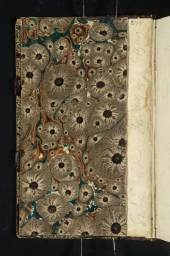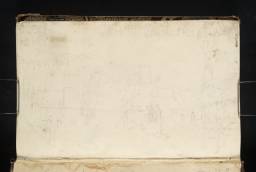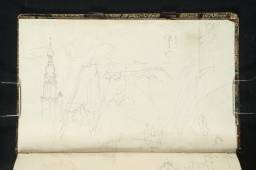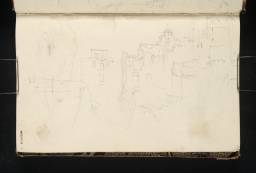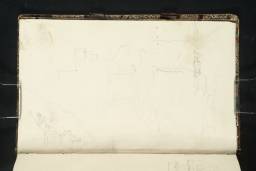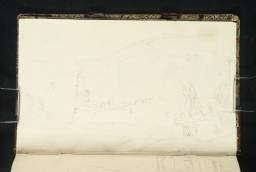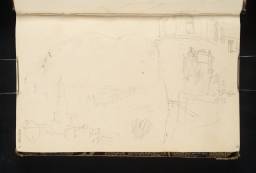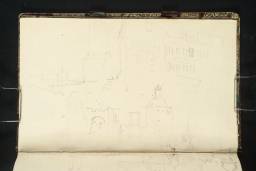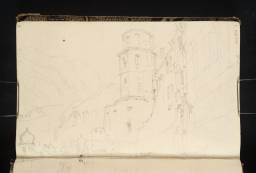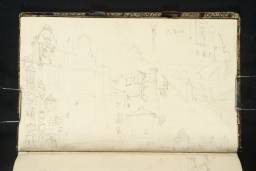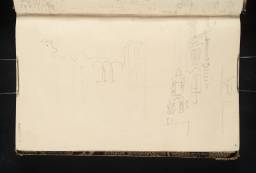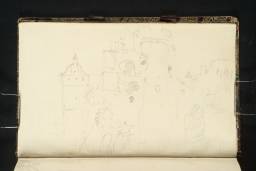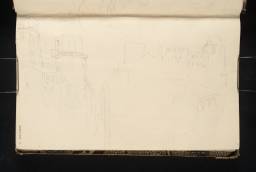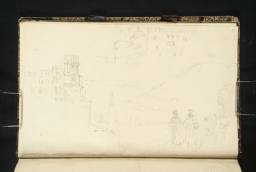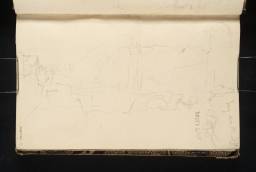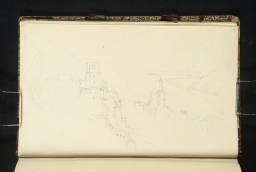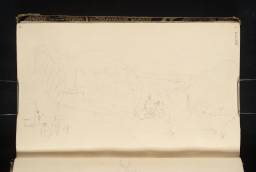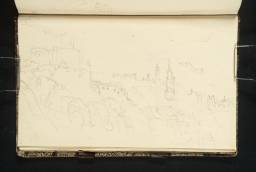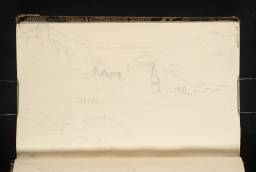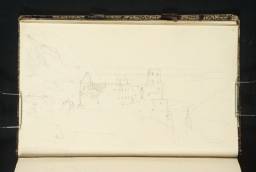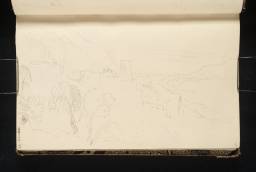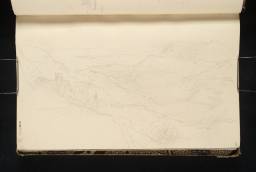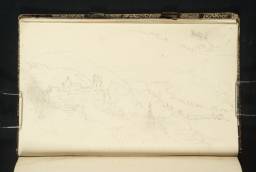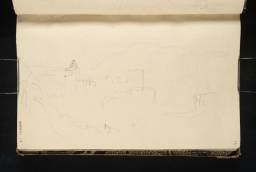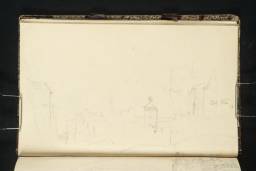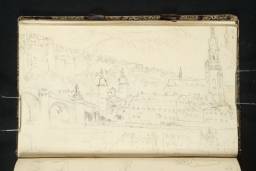Turner Bequest CCXCVIII 1–98a
Sketchbook quarter bound in grey, teal and purple marbled boards with spine in brown marbled paper
Pouch made from grey, teal and brown marbled paper on inside front cover
Four brown leather or parchment loops affixed at top and bottom of inside front and back covers
Inscribed in pencil by Turner ‘G[...] D[...] Heidelberg up to Salzburg’ inside front cover
Foredge inscribed with inked lines
Inscribed in pencil ‘599’ inside front cover
Signed by ‘H.S. Trimmer’ (Henry Scott Trimmer) in black ink and inscribed ‘No 235. | Containing 95 Leaves | Pencil sketches most on both sides – ’ on Tate D30001; Turner Bequest CCXCVIII 98a
Signed in black ink by ‘C. Turner’ (Charles Turner) and in pencil by ‘C.L.E.’ (Charles Locke Eastlake) and ‘JPK’ (John Prescott Knight) on Tate D30001; Turner Bequest CCXCVIII 98a
Blind-stamped with Turner Bequest monogram on spine of front and back covers and at centre on Tate D30001; Turner Bequest CCXCVIII 98a
Stamped in black ‘CCXCVIII’ top of front and back covers and inside back cover
98 leaves of cream wove paper and off-white lined paper
Watermarked ‘j.whatman’
Approximate size of page 165 x 110 mm
Pouch made from grey, teal and brown marbled paper on inside front cover
Four brown leather or parchment loops affixed at top and bottom of inside front and back covers
Inscribed in pencil by Turner ‘G[...] D[...] Heidelberg up to Salzburg’ inside front cover
Foredge inscribed with inked lines
Inscribed in pencil ‘599’ inside front cover
Signed by ‘H.S. Trimmer’ (Henry Scott Trimmer) in black ink and inscribed ‘No 235. | Containing 95 Leaves | Pencil sketches most on both sides – ’ on Tate D30001; Turner Bequest CCXCVIII 98a
Signed in black ink by ‘C. Turner’ (Charles Turner) and in pencil by ‘C.L.E.’ (Charles Locke Eastlake) and ‘JPK’ (John Prescott Knight) on Tate D30001; Turner Bequest CCXCVIII 98a
Blind-stamped with Turner Bequest monogram on spine of front and back covers and at centre on Tate D30001; Turner Bequest CCXCVIII 98a
Stamped in black ‘CCXCVIII’ top of front and back covers and inside back cover
98 leaves of cream wove paper and off-white lined paper
Watermarked ‘j.whatman’
Approximate size of page 165 x 110 mm
Accepted by the nation as part of the Turner Bequest 1856
Exhibition history
References
Named after an inscription by Turner himself (Tate D41209), the Heidelberg up to Salzburg sketchbook was the second to be used on the 1833 tour to Venice via Germany and Austria. Purchased in Heidelberg, it is bound in grey, teal and purple marbled boards, with a spine rendered in brown marbled paper. The ‘j.whatman’ watermarked paper is forged: produced not at the renowned Whatman mill in Kent but on the continent, in France, Germany or Austria.1
The sketchbook opens with around fifty drawings of Heidelberg, a city new to Turner despite his extensive travels in the nearby Rhine valley (Tate D29814–D29864; Turner Bequest CCXCVIII 1–26).2 Turner focussed his attentions on Heidelberg Castle: the former seat of the Electoral Palatinate and Holy Roman Empire which lay largely in ruin following attacks during the Thirty Years’ (1618–48) and Nine Years’ (1688–97) Wars. Sketches record the apartments, towers, terraces and gardens of the Castle from various vantage points, some of which afforded excellent views over Heidelberg itself (see, for example, Tate D29822–D28923, D29825, D29827; Turner Bequest CCXCVIII 5–5a, 6a, 7a). Turner also explored the city from banks of the Neckar, producing a detailed two-page prospect of the old town and Castle on Tate D29840–D29841; Turner Bequest CCXCVIII 14–14a and a study of the Castle and Karlstor from the Hirchgasse on Tate D29845; Turner Bequest CCXCVIII 16a.
Turner then made for Stuttgart by road, passing through Sinsheim where he encountered a local funeral procession (Tate D29872; Turner Bequest CCXCVIII 30). He followed the Neckar valley via Lauffen and Kirchheim before entering Stuttgart (Tate D29887–D29906; Turner Bequest CCXCVIII 37a–47). These drawings are quite valuable records of the city in the 1830s as it was historically considered ‘off the beaten track’ by most British topographical artists. 3 However, as Ian Warrell notes in the general introduction to this tour, Turner may have been inclined to visit the city on the back of recommendations from his friend and fellow artist, George Jones (1786–1869).
Turner then made for Stuttgart by road, passing through Sinsheim where he encountered a local funeral procession (Tate D29872; Turner Bequest CCXCVIII 30). He followed the Neckar valley via Lauffen and Kirchheim before entering Stuttgart (Tate D29887–D29906; Turner Bequest CCXCVIII 37a–47). These drawings are quite valuable records of the city in the 1830s as it was historically considered ‘off the beaten track’ by most British topographical artists. 3 However, as Ian Warrell notes in the general introduction to this tour, Turner may have been inclined to visit the city on the back of recommendations from his friend and fellow artist, George Jones (1786–1869).
Passing through Ulm (Tate D29932, D29943–D29946; Turner Bequest CCXCVIII 60, 65a–67), Turner’s next destination was Munich (Tate D29956–D29964, D29971; Turner Bequest CCXCVIII 72–75a, 79a). The city was then in the midst of a great architectural transformation conceived by Ludwig I (1786–1868) and executed by his architects Leo von Klenze (1784–1864) and Friedrich von Gärtner (1791–1847). The Pinakothek, a new art gallery, was still in the final phases of construction when Turner came to Munich in 1833 (Tate D29926; Turner Bequest CCXCVIII 57), but the Glyptothek, a gallery housing the king’s antique sculptures, had been recently completed. The building and one of its celebrated exhibits the ‘Ilioneus’ is recorded in sketches on Tate D29886, D29916, D29918, D29925, D29974, D29995; Turner Bequest CCXCVIII 37, 52, 53, 56a, 81, 95.4
Via Wasserburg am Inn Turner travelled across Bavaria to Salzburg, at the northern border of the Alps (Tate D29965, D29969; Turner Bequest CCXCVIII 76a). It was by now mid August. A city praised by contemporary artists and writers Turner’s exploration of Salzburg was comprehensive: recorded in the final pages of this sketchbook (Tate D29969–D29970, D29972, D29986; Turner Bequest CCXCVIII 78a–79, 80, 88) and in the Salzburg and Danube, the third sketchbook of the 1833 tour(Tate D30130–D30266; D30268–D30295; D41223–D41224; Turner Bequest CCC 1–84a).5
Powell 1995, p.113; see also Peter Bower, ‘The white art: the importance of interpretation in the analysis of paper’ Looking at Paper, Evidence and Interpretation Symposium, Toronto, Canadian Conservation Institute, 1999, p.12.
See David Hill, ‘In Turner’s Footsteps at Heidelberg: Part 1’, Sublime Sites, <accessed 10 October, 2017
The ‘Ilioneus’, Perseus Digital Library, accessed 10 October 2017, http://www.perseus.tufts.edu/hopper/artifact?name=Munich+GL+270&object=sculpture
How to cite
Alice Rylance-Watson, ‘Heidelberg up to Salzburg sketchbook’, sketchbook, May 2017, in David Blayney Brown (ed.), J.M.W. Turner: Sketchbooks, Drawings and Watercolours, Tate Research Publication, March 2023, https://www

